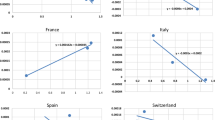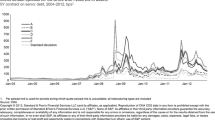Abstract
This paper estimates the shadow price of equity for U.S. commercial banks over 2001–2018 using nonparametric local-linear estimators of the underlying cost frontier and tests the existence of “Too-Big-to-Fail” (TBTF) banks. Evidence for the existence of TBTF banks is found. We find that a negative correlation exists between the shadow price of equity and the size of banks in each year, suggesting that big banks pay less for equity than small banks. In addition, in each year there are more banks with a negative shadow price of equity in the fourth quartile based on total assets than in the other three quartiles. The data also reveal that for each year, the estimated mean shadow price of equity for the 50 largest banks is smaller than the mean price of deposits, even though equity is commonly viewed as a riskier asset than deposits. Finally, we find that the top 10 largest banks are willing to pay much more at the start of the global financial crisis and after the Dodd-Frank Wall Street Reform and Consumer Protection Act of 2010 than the other periods. These results imply that these regulations are effective in reducing the implicit subsidy, at least for the top 10 largest banks. However, it is also evident that the recapitalization has imposed significant equity funding costs for the top 10 largest banks.







Similar content being viewed by others
Notes
For the discussions of these facilities, see https://www.federalreserve.gov/monetarypolicy/bst_lendingother.htm.
“Curse of dimensionality” refers to decreasing convergence rates with increasing numbers of dimensions, a common phenomenon among nonparametric estimators. In this paper, the number of dimensions corresponds to the number of distinct independent variables included in our regressions.
As an aside, note that rearranging terms in (2.6) and expressing it in elasticity form gives.
The data are available at https://cdr.ffiec.gov/public/PWS/DownloadBulkData.aspx.
Note that in studies involving parametric regression problems, there is seldom (if ever) any consideration of the effects of large dimensionality, i.e., of having many regressors appear on the RHS of the regression equation. While the rates of convergence of ordinary least squares and related parametric estimators keep their root-n rates of convergence regardless of the number of regressors, one does not escape the curse of dimensionality in such problems since mean-square error increases with the number of RHS regressors in parametric regression problems. See Wilson (2018) for explanation and discussion. Also in parametric regression problems, multicollinearity is typically regarded as an annoying nuisance, but in our nonparametric framework, we are able to exploit multicollinearity to reduce dimensionality as seen below.
Dimension reduction is widely used in nonparametric regression problems to alleviate the curse of dimensionality. Wilson (2018) employs massive simulation experiments to demonstrate the benefits of dimension reduction in the context of nonparametric, deterministic frontier estimation, and finds that in many situations, the sacrifice of a small amount of information to reduce the number of dimensions substantially reduces estimation error.
The details of our estimation framework are similar to those given in Wheelock and Wilson (2020). We give the details here to aid the reader.
As discussed earlier, we take logs of the variables used to define Zi in (4.1) in order to reduce the skewness in the marginal distributions. Even so, the data still exhibit some skewness after this initial transformation, and this is reflected in the principle components that we use for dimension-reduction and estimation. When estimating (4.7) at a particular point, our nearest-neighbor bandwidth is determined by the distance from this particular point to the Kth nearest point, thereby adapting to local sparseness or denseness in the data. We select K by minimizing the leave-one-out, least-squares cross-validation function over integer values for K. See Fan and Gijbels (1996) for details on the local-linear estimator and additional discussion.
For the details about the derivation of the shadow price of equity, see the separate Appendix A. For details on local-linear estimation, see Fan and Gijbels (1996). Note that from (4.15), it is clear that shadow prices for inefficient banks are estimated at the point where they are projected onto the frontier in the direction in which efficiency is measured. Of course the shadow prices depend on the direction chosen to project inefficient firms onto the frontier, but the choice made in (4.15) is the only sensible choice in the context of our model.
Härdle and Mammen (1993) demonstrate that a naive bootstrap based on resampling the estimated residuals or the data (uniformly, with replacement) to construct bootstrap samples does not provide valid inference in the context of nonparametric regression estimators such as our local-linear estimator, due to the bias of such estimators. Härdle and Mammen (1993) develop the so-called “wild bootstrap” to provide valid inference; the idea is to re-create in the “bootstrap world” the bias that exists in the “real world.” For each observation i, a bootstrap residual \({\varepsilon }_{i}^{* }\) is constructed, such that \({\varepsilon }_{i}^{* }=\frac{1-\sqrt{5}}{2}{\varepsilon }_{i}\) with probability \(\frac{1+\sqrt{5}}{2\sqrt{5}}\) and \({\varepsilon }_{i}^{* }=\frac{1+\sqrt{5}}{2}{\varepsilon }_{i}\) with probability \(\frac{\sqrt{5}-1}{2\sqrt{5}}\). In terms of (4.7), the bootstrap residuals are used to compute \({{{{\mathcal{Y}}}}}_{i}^{* }={\widehat{r}}_{1}({{{{\boldsymbol{\Psi }}}}}_{i})+{\varepsilon }_{i}^{* }\) for i = 1, …, n where \({\widehat{r}}_{1}({{{{\boldsymbol{\Psi }}}}}_{i})\) is the estimated value of r1(Ψi) in (4.7). Then the \({{{{\mathcal{Y}}}}}_{i}^{* }\) are regressed on the Ψi in each of B bootstrap replications. See Härdle (1990) or Härdle and Mammen (1993) for additional details and discussion.
References
Baker D, Mcarthur T (2009) The value of the “Too Big to Fail” big bank subsidy. Issue Brief, Center for Economic and Policy Research (Washington). Available at https://www.cepr.net/documents/publications/too-big-to-fail-2009-09.pdf
Bernanke BS (2005) Remarks by Governor Ben s. Bernanke: The global saving glut and the U.S. current account deficit, Board of Governors of the Federal Reserve System. Speech delivered April 14, http://www.federalreserve.gov.boarddocs/speeches/2005/20050414/default.htm
Boucinha M, Ribeiro N, Weyman-Jones T (2013) An assessment of Portuguese banks’ efficiency and productivity towards euro area participation. J Productivity Anal 39:177–190
Braeutigam RR, Daughety AF (1983) On the estimation of returns to scale using variable cost functions. Economics Lett 11:25–31
Brewer E, Jagtiani J (2013) How much did banks pay to become too-big-to-fail and to become systemically important? J Financial Services Res 43:1–35
Caves DW, Christensen LR, Swanson JA (1981) Productivity growth, scale economies, and capacity utilization in U.S. railroads, 1955-74. Am Economic Rev 71:994–1002
Demirgüç-Kunt A, Huizinga H (2013) Are banks too big to fail or too big to save? International evidence from equity prices and CDS spreads. J. Banking Finance 37:875–894
Dong Y, Firth M, Hou W, Yang W (2016) Evaluating the performance of Chinese commercial banks: a comparative analysis of different types of banks. Eur J Operational Res 252:280–295
Duygun M, Shaban M, Sickles RC, Weyman-Jones T (2015) How a regulatory capital requirement affects banks’ productivity: An application to emerging economies. J Productivity Anal 44:237–248
Fan J, Gijbels I (1996) Local polynomial modelling and its applications. Chapman and Hall, London
Fethi MD, Shaban M, Weyman-Jones T (2012) Turkish banking recapitalization and the financial crisis: An efficiency and productivity analysis. Emerging Markets Finance Trade 48:76–90
Fiordelisi F, Radić N, Weyman-Jones T (2018) Bank performance and the shadow price of capital. Unpublished working paper, Facoltà di Economia, Università degli Studi RomaTre.
Gandhi P, Lustig H, Plazzi A (2020) Equity is cheap for large financial institutions. Rev Financial Stud33:4231–4271
Hall P (1992) The bootstrap and edgeworth expansion. Springer-Verlag, New York
Härdle W (1990) Applied nonparametric regression. Cambridge University Press, Cambridge
Härdle W, Mammen E (1993) Comparing nonparametric versus parametric regression fits. Ann. Statistics 21:1926–1947
Hasannasab M, Margaritis D, Staikouras C (2019) The financial crisis and the shadow price of bank capital. Ann Operations Res 282:131–154
Hughes JP (1999) Incorporating risk into the analysis of production. Atlantic Economic J 27:1–23
Hughes JP, Mester LJ, Moon CG (2001) Are scale economies in banking elusive or illusive? evidence obtained by incorporating capital structure and risk-taking into models of bank production. J Banking Finance 25:2169–2208
McAllister PH, McManus D (1993) Resolving the scale efficiency puzzle in banking. J Banking Finance 17:389–405
Radić N (2015) Shareholder value creation in Japanese banking. J Banking Finance 52:199–207
Restrepo DA, Kumbhakar SC, Sun K (2013) Are U.S. commercial banks too big? Universidad EAFIT, Columbia; Documentos de trabajo Economía y Finanzas No 13-14, available at SSRN: https://ssrn.com/abstract=2393161 or https://doi.org/10.2139/ssrn.2393161
Robinson PM (1988) Root-n -consistent semiparametric regression. Econometrica 56:931–954
Santos JAC (2014) Evidence from the bond market on banks’ “Too-Big-to-Fail” subsidy. FRBNY Economic Policy Review 20:29–39
Sealey C, Lindley J (1977) Inputs, outputs, and a theory of production and cost at depository financial institutions. J Finance 32:1251–1266
Simar L, Van Keilegom I, Zelenyuk V (2017) Nonparametric least squares methods for stochastic frontier models. J Productivity Anal 47:189–204
Simar L, Wilson PW (2007) Estimation and inference in two-stage, semi-parametric models of productive efficiency. Journal of Econometrics 136:31–64
Simar L, Wilson PW (2011) Two-stage DEA: caveat emptor. J Productivity Anal 36:205–218
Ueda K, Weder di Mauro B (2013) Quantifying structural subsidy values for systemically important financial institutions. J Banking Finance 37:3830–3842
Weyman-Jones T (2016) Efficiency, competition and the shadow price of capital. In: Haven E, Molyneux P, Wilson JOS, Fedotov S, Duygun M (eds) The handbook of post crisis financial modeling. Palgrave Macmillan, London, UK, p 147–167.
Wheelock DC, Wilson PW (2001) New evidence on returns to scale and product mix among U.S. commercial banks. J Monetary Economics 47:653–674
Wheelock DC, Wilson PW (2012) Do large banks have lower costs? new estimates of returns to scale for U.S. banks. J Money Credit Banking 44:171–199
Wheelock DC, Wilson PW (2018) The evolution of scale-economies in U.S. banking. J Appl Econometrics 33:16–28
Wheelock DC, Wilson PW (2020) New estimates of the lerner index of market power for U.S. banks. Unpublished working paper, Department of Economics, Clemson University, Clemson, SC, USA
Wilson PW (2018) Dimension reduction in nonparametric models of production. Eur J Operational Res 267:349–367
Acknowledgements
An early version of this work was presented at the North American Productivity Workshop XI, University of Miami Business School, Miami, Florida, 8–12 June 2020. We thank the Cyber Infrastructure Technology Integration group at Clemson University for operating the Palmetto cluster used for computations. Babur De los Santos, Matthew Lewis and participants in the Industrial Organization Workshop at the John E. Walker Department of Economics, Clemson University made helpful comments on early versions of our work. We thank Shannon Graham for her careful edits. All remaining errors are our own. The views expressed herein do not necessarily reflect views of the Federal Reserve Bank of St. Louis nor the Federal Reserve System.
Author information
Authors and Affiliations
Corresponding authors
Ethics declarations
Conflict of interest
Part of the work on this paper was done while Wilson held a consulting contract and Visiting Scholar relationship with the Federal Reserve Bank of St. Louis. Otherwise, the authors declare that they have no competing financial interests nor personal relationships that could have appeared to influence the work reported in this paper. As noted on the title page, the views expressed herein do not necessarily reflect views of the Federal Reserve Bank of St. Louis nor the Federal Reserve System.
Additional information
Publisher’s note Springer Nature remains neutral with regard to jurisdictional claims in published maps and institutional affiliations.
Supplementary information
Rights and permissions
About this article
Cite this article
Wilson, P.W., Zhao, S. Evidence from shadow price of equity on “Too-Big-to-Fail” Banks. J Prod Anal 57, 23–40 (2022). https://doi.org/10.1007/s11123-021-00619-8
Accepted:
Published:
Issue Date:
DOI: https://doi.org/10.1007/s11123-021-00619-8




